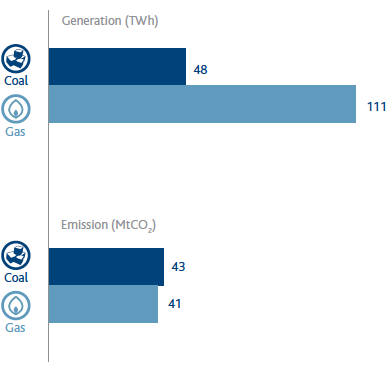Natural gas and innovation
Natural gas is the only fuel which, together with non-programmable renewable resources such as wind and photovoltaic power, can guarantee an efficient decarbonisation route, effective at national and European level.
For the same amount of energy produced, the combustion of methane gas produces between 25% and 40% less carbon dioxide compared with fossil fuels and it does not contain particulates.
This is because gas is a versatile product which can be used as an energy source for domestic uses, for generating electricity, for industrial uses and as a fuel for transportation by road and by sea.
Greater use of gas in its various forms would translate into less emissions of sulphur dioxide, nitrogen oxides and particulate matter, with a decisive impact on fighting air pollution in cities, and would contribute to decreasing the role of oil and its derivatives.
Gas is an accessible source, given the presence of considerable reserves near Europe and the development of the liquefied natural gas global market which has increased availability at low prices.
Lastly, the gas system can count on existing transportation, storage and distribution systems and is capable of supporting Italian and European decarbonisation guaranteeing the energy system flexibility, programmability and cost effectiveness. This is also thanks to a gas-based electricity generation capacity that is already widely available and extremely efficient.
ELECTRICITY GENERATION AND CO2 EMISSIONS IN ITALY (2015)

As well as its multiple uses, natural gas is the element enabling advanced technologies for decarbonisation.
The gas infrastructure system is
Widely developed
Very limited investments can support energy production and user technologies with a low or zero carbon content (gas-powered, biomethane, micro-cogeneration, turbo-expansion, power-to-gas heat pumps).
Flexible to respond to fluctuations in demand and supply
Energy masses can be moved in economical and efficient times and spaces and production and consumption technologies based on renewable gases can be integrated immediately
Efficient and fair in allocating costs
In any event, decentralised energy generation/consumption systems require network structures where the cost must be borne by all possible users.
Gas and technological innovation for fighting climate change
Power to Gas
The natural gas network can play an essential part in managing the ever-increasing volumes obtained from renewable sources.
The excess electricity produced by solar power stations or wind farms can actually be converted into hydrogen through an electrolysis process and then enriched with CO2, making it possible to produce a syngas to be injected into the network.
This avoids investment costs in new infrastructures for the transmission, distribution and storage of electricity.
In Italy, for over 70 years so-called town gas, made up of mixtures with 50% hydrogen content has been distributed in cities without problems.
Europe is keeping a careful eye on the new technology, which has already been included in the German national energy programme.
Gas-powered Heat Pumps
This is a technology that makes it possible to combine the many advantages of natural gas with the operating principle of heat pumps.
Thanks to the exploitation of ambient heat, which is renewable and free, it is actually possible to improve output compared with normal condenser gas boilers.
Output indicates the useful energy produced with the gas energy used.
The optimum output of a condenser boiler is equal to approximately 110%, but with gas-powered heat pumps it is possible to achieve a figure of up to 170%.